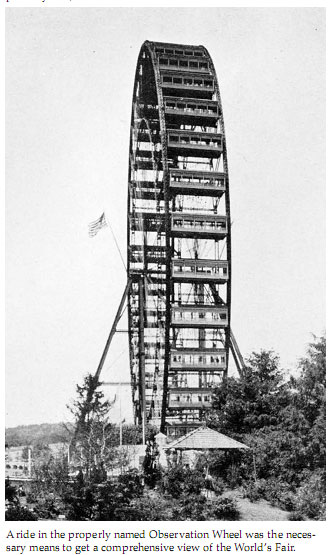
THE FERRIS WHEEL When Visiting the World’s Fair Ride on the Ferris Wheel.
The great Expositions held during the last fifteen years have produced two marvelous examples of engineering and constructive ability. One of these, the Eif fel Tower, was designed and built by a Frenchman at Paris for the Exposition of 1889; the other, the Ferris Wheel, was designed and built by the late George W. G. Ferris for the World’s Columbian Exposition at Chicago in 1893. Paris again held a great Exposition in 1900 but failed to produce any feature to take the place of the Eiffel Tower. In America, St. Louis, in 1904 planned and produced the greatest Exposition the world has ever seen. Scores of attempts were made to invent something more wonderful and more attractive than the Ferris Wheel, but as Paris failed to outdo her own Eiffel Tower, so did St. Louis fail to equal the far-famed Ferris Wheel of the Columbian Exposition of 1893. Arrangements were according- ly made to bring the Ferris Wheel to the Louisiana Purchase Exposition, and it was given a location near the geo- graphical center of the grounds. The problem of moving the Ferris wheel from Chicago to St. Louis was stupendous— 4,200 tons of material, includ- ing the 70-ton axle, besides engines, boilers and derricks and false work, had to be trans- ported. One hundred and sev- enty five freight cars were required to move this material. A brief resume of the dimen- sions and description of the Ferris Wheel may be interest- ing. The wheel is built upon the bicycle principle, with immense tension spokes, 2 15/16 in. diameter. The wheel is 250 feet in diameter and stands 264 feet high. In reality it is two wheels securely braced together. Between the outer rims of these wheels the eleven-ton cars are suspended on 6 1/2 in. pins 6 feet long, 9 feet high and will carry 60 persons each. There are 36 of them, so the total capacity of the wheel is 2,160 persons. At several times in its
history the wheel has been filled to its capacity. The axle of the wheel is a solid steel forg- ing, 32 in. in diameter and 45 feet long. The solid bronze bearings upon which it rests are each 6 feet square on top and 40 x 50 feet at the base. These in turn rest upon solid concrete and steel beam pillars which are carried down to solid rock, 26 feet below the surface of the ground. The towers are anchored to the bottom of their mass of concrete by 2×6 inch eyebars, so that the wheel is perfectly safe, even in the most
violent storms. The side vibra- tion of the wheel in an 80 mile an hour wind is less than 1/2 inch. The wheel is run by a double reversing engine with cylinders 30×48 in., capable of developing 2,000 horse power. The power is applied through a series of cogs to a sprocket chain which engages wide cogs on the outside of each rim. When you come to the Fair, do not fail to ride upon it.
Pulaski County Democrat
September 16, 1904
